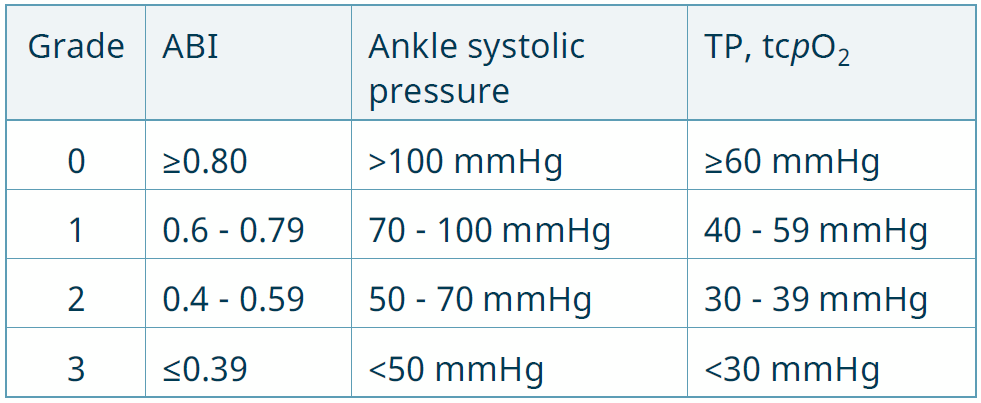Select your destination
Continue to Radiometer Medical
Transcutaneous oxygen (tcpO2) measurement in the management of chronic limb threatening ischemia
Transcutaneous oxygen (tcpO2) measurement in the management of chronic limb threatening ischemia
An increasing number of patients around the globe suffer from chronic limb-threatening ischemia (CLTI) also known as Chronic Limb Ischemia (CLI), which is the end-stage of peripheral artery disease (PAD) [1]. CLTI is associated with high mortality, delayed wound healing, major limb amputation, pain, and diminished quality of life [1].
CLTI is more common in diabetics, people with cardiovascular disease, hyperlipidemia, smokers and males, and the incidence increases with age [1].
CLTI leads to a substantial economic burden due to surgery and the costs of rehabilitation, medicine, nursing homes, and internal medicine [2]
Diagnosis of CLTI in current guidelines
The Global Vascular Guidelines recommend ankle pressure (AP) and ankle-brachial index (ABI) as the first line screening for CLTI [1]. Transcutaneous oximetry is recommended as an alternative method for diagnosis [1].
The Society of Vascular Surgery (SVS) has created a risk stratification system that is based on three major factors that impact amputation risk and clinical management: wound, ischemia, and foot infection (WIfI) (Table 1) [3]. The WIfI classification recommends tcpO2 or toe pressure (TP) over ABI in diabetics and the elderly [4].

Table 1. WIfI classification
Diagnosis of CLTI in diabetic patients
In patients with calcified vessels the AP and ABI can be falsely elevated due to incompressible vessels, which can lead to an overestimation of the AP and ABI [3]. This is common in diabetics, where 30 to 40% of patients are estimated to have calcified vessels [3]. In these instances, transcutaneous oximetry (tcpO2) might be preferable to AP and ABI [4]. A recent systematic review by the International Working Group of the Diabetic Foot (IWGDF) of 15 studies published between 1980 and 2018, covering 6800 patients suffering from diabetes and foot ulcerations, showed that low ABI, AP, TP and transcutaneous oximetry (tcpO2) was useful to predict the likelihood of amputation [5].
However, ABI values were not useful to predict the likelihood of wound healing – an ABI can present normal values due to calcified vessels. Here the authors conclude that using tcpO2, toe pressure or skin perfusion pressure (SPP) is recommendable [5]. Hence IWGDF has three important recommendations in relation to patients with PAD, CLTI, and/or diabetic foot (Table 2) [4].
|
Table 2. Recommendations from IWGDF
tcpO2 and relation to clinical outcomes in CLTI
A meta-analysis by Arsenault and colleagues, including 31 studies with over 1800 patients, showed that values of transcutaneous oxygen predicted risk of healing complications and amputation. A value of transcutaneous oxygen of less than 40 mmHg resulted in a 24% increased risk of healing complication, and this risk increased with lower tcpO2 values [6].
Two studies published study by Fagher and colleagues showed that tcpO2 is an independent prognostic marker for 1-year mortality in diabetes patients with foot ulcers and that patients with abnormal ABI and tcpO2 < 30 mmHg had more than twice as high 3-year mortality compared to patients with normal ABI and tcpO2 [7, 8].
A cohort study by Salaun et al, of patients hospitalized for peripheral arterial disease, enrolled 556 patients with CLTI [9]. Major amputation rate was compared according to initial ankle pressure (AP), systolic toe pressure (STP), and forefoot tcpO2. AP failed to identify 42% of patients with CLTI. The authors conclude that systolic toe pressure <30 mmHg or tcpO2 <10 mmHg are the best predictive thresholds for major amputation, and that AP should not be used in the definition of a patient with CLTI [9].
Other applications of tcpO2
Pardo and colleagues compared tcpO2 to ABI in patients undergoing peripheral transluminal angioplasty (PTA) to treat CLTI before, during and after the procedure [10]. ABI could not be determined in 15% of patients, whereas it was possible to measure tcpO2 in all patients.
It was also possible to measure tcpO2 perioperatively - during the procedure - and the tcpO2 values shoved variations during the procedure that corresponded with revascularization.
After the procedure, tcpO2 increased steadily over the course of 8 weeks, even if the ABI did not change, suggesting “the usefulness of determining tcpO2 after PTA as a valuation technique of revascularization achieved after the radiological procedure”.
A small study by Cuen-Ojeda et al., showed that tcpO2 was significantly lower in patients with severe post-thrombotic syndrome compared to non-severe post-thrombotic syndrome and healthy controls, and suggest that tcpO2 might be useful in determining wound healing potential for this condition [11].
Xue and colleagues showed that transcutaneous oxygen and carbon dioxide (tcpCO2) differed significantly between patients at high and low risk for pressure ulcers, and that change in tcpCO2 and tcpO2 from lateral to supine position was higher in high-risk compared to low-risk patients [12]. The authors hypothesize that tcpO2 and tcpCO2 can be used as an objective scientific measurement to evaluate the risk of pressure ulcers.
Summary
The incidence of CLTI is increasing around the world and is associated with substantial morbidity, mortality, and health care costs. Transcutaneous monitoring of oxygen (tcpCO2) provides non-invasive monitoring of the oxygen tension of the skin and hence the microvascular function. tcpCO2 is correlated to wound healing prognosis and long-term morbidity in CLTI and diabetic wounds and has potential applications within several areas of wound care and wound prevention.
References
1.Conte MS, Bradbury AW, Kolh P et al. Global Vascular Guidelines on the Management of Chronic Limb-Threatening Ischemia. European journal of vascular and
endovascular surgery: the official journal of the European Society for Vascular Surgery 2019; 58, 1S: S1-S109.e33.
2.Raghav A, Khan ZA, Labala RK, Ahmad J, Noor S, Mishra BK. Financial burden of diabetic foot ulcers to world: A progressive topic to discuss always.
Therapeutic advances in endocrinology and metabolism 2018; 9, 1: 29–31.
3.Mills JL, Conte MS, Armstrong DG et al. The Society for Vascular Surgery Lower Extremity Threatened Limb Classification System: Risk stratification based on
wound, ischemia, and foot infection (WIfI). Journal of vascular surgery 2014; 59, 1: 220-34.e1-2.
4.Hinchliffe RJ, Forsythe RO, Apelqvist J et al. Guidelines on diagnosis, prognosis, and management of peripheral artery disease in patients with foot ulcers and
diabetes (IWGDF 2019 update). Diabetes/metabolism research and reviews 2020; 36 Suppl 1: e3276.
5.Forsythe RO, Apelqvist J, Boyko EJ et al. Performance of prognostic markers in the prediction of wound healing or amputation among patients with foot ulcers
in diabetes: A systematic review. Diabetes/metabolism research and reviews 2020; 36 Suppl 1: e3278.
6.Arsenault KA, Al-Otaibi A, Devereaux PJ, Thorlund K, Tittley JG, Whitlock RP. The use of transcutaneous oximetry to predict healing complications of lower limb
amputations: A systematic review and meta-analysis. European journal of vascular and endovascular surgery: the official journal of the European Society for
Vascular Surgery 2012; 43, 3: 329–36.
7.Fagher K, Katzman P, Löndahl M. Transcutaneous oxygen pressure as a predictor for short-term survival in patients with type 2 diabetes and foot ulcers: A
comparison with ankle-brachial index and toe blood pressure. Acta diabetologica 2018; 55, 8: 781–88.
8.Fagher K, Löndahl M. The combined impact of ankle-brachial index and transcutaneous oxygen pressure on mortality in patients with type 2 diabetes and
foot ulcers. Acta diabetologica 2021; 58, 10: 1359–65.
9.Salaun P, Desormais I, Lapébie F-X et al. Comparison of Ankle Pressure, Systolic Toe Pressure, and Transcutaneous Oxygen Pressure to Predict Major
Amputation After 1 Year in the COPART Cohort. Angiology 2019; 70, 3: 229–36.
10.Pardo M, Alcaraz M, Bernal FL, Felices JM, Achel GD, Canteras M. Transcutaneous oxygen tension measurements following peripheral transluminal
angioplasty procedure has more specificity and sensitivity than ankle brachial index. The British journal of radiology 2015; 88, 1046: 20140571.
11.Cuen-Ojeda C, Anaya-Ayala JE, Laparra-Escareno H et al. Measurement of transcutaneous oxygen pressure in patients with post-thrombotic syndrome:
Findings and possible clinical applications. Vascular 2020; 28, 2: 172–76.
12.Xue M, Wang D, Zhang Z et al. Demonstrating the Potential of Using Transcutaneous Oxygen and Carbon Dioxide Tensions to Assess the Risk of Pressure
Injuries. International journal of biological sciences 2018; 14, 11: 1466–71.
Cookies are used on this website
Use of cookiesPlease enter a valid email
We will be sending an e-mail invitation to you shortly to sign in using Microsoft Azure AD.
It seems that your e-mail is not registered with us
Please click "Get started" in the e-mail to complete the registration process
Radiometer is using Microsoft AZURE Active Directory to authenticate users
Radiometer uses Azure AD to provide our customers and partners secure access to documents, resources, and other services on our customer portal.
If your organization is already using Azure AD you can use the same credentials to access Radiometer's customer portal.
Key benefits
- Allow the use of existing Active Directory credentials
- Single-sign on experience
- Use same credentials to access future services
Request access
You will receive an invitation to access our services via e-mail when your request has been approved.
When you accept the invitation, and your organization is already using AZURE AD, you can use the same credentials to access Radiometer's customer portal. Otherwise, a one-time password will be sent via e-mail to sign in.
